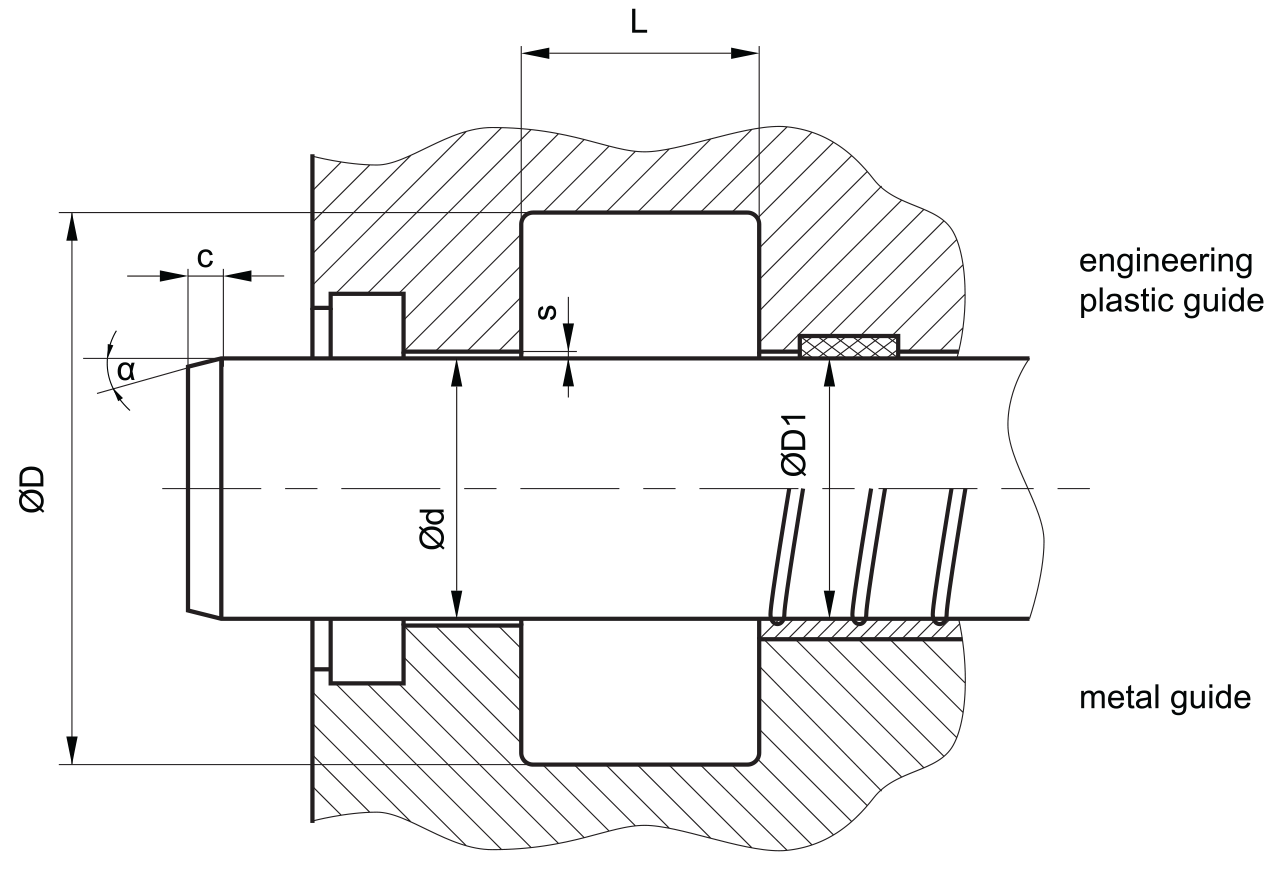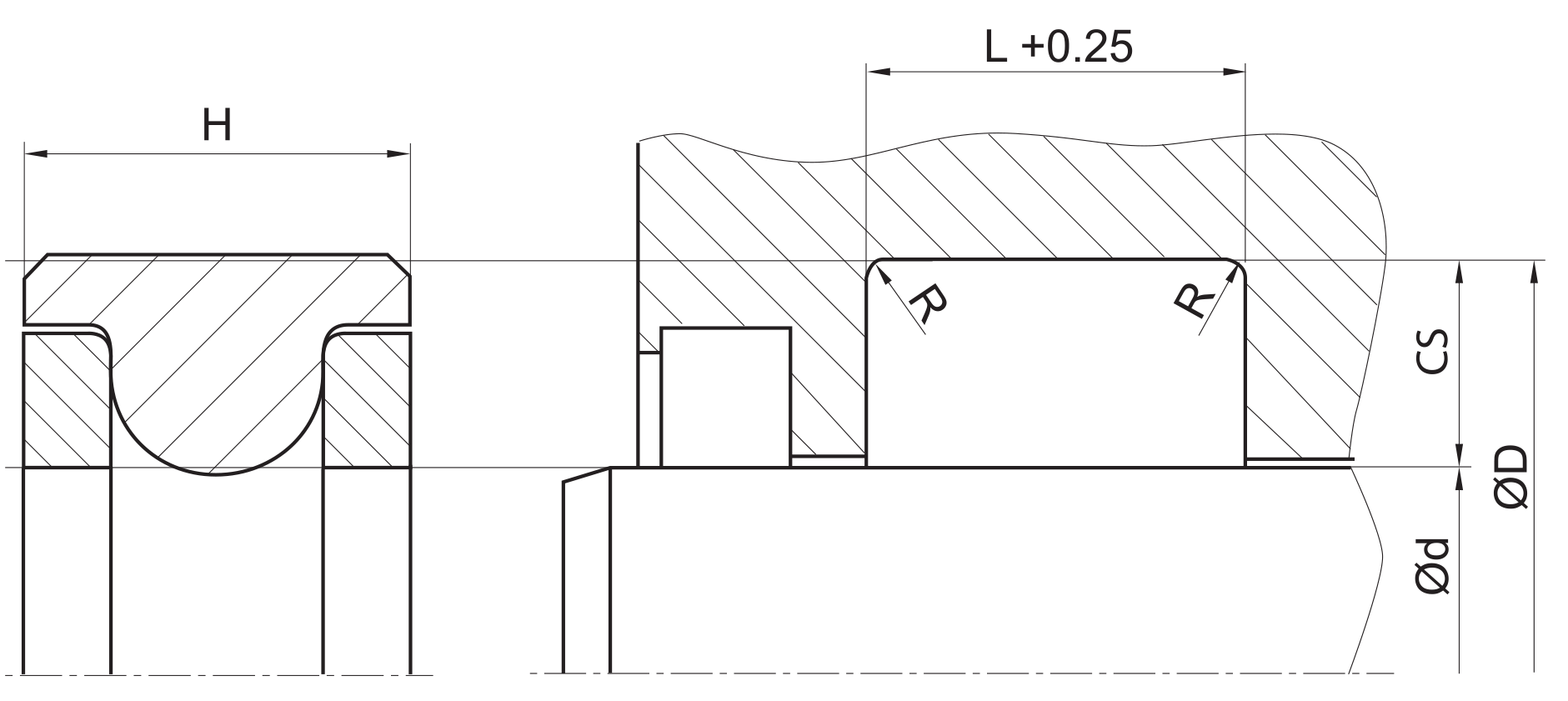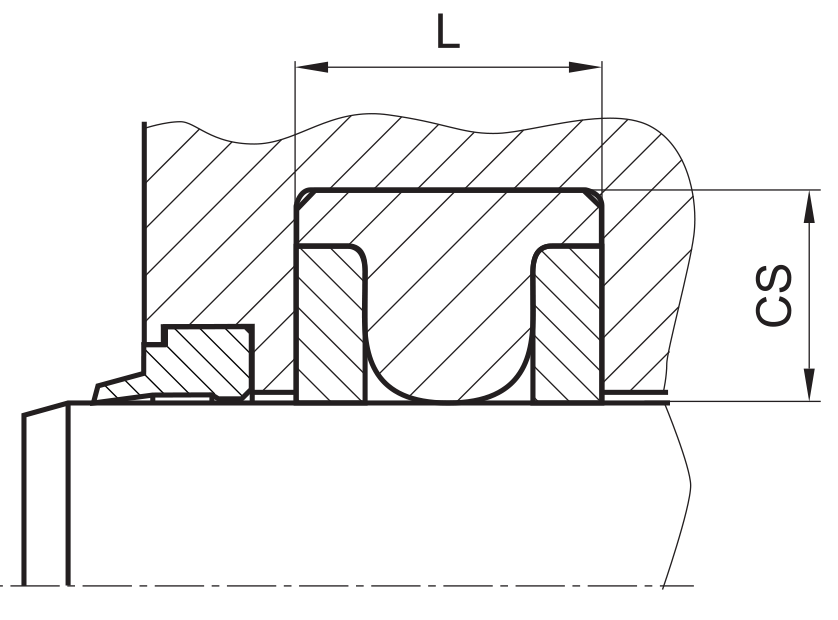

description
O-Ring activated symmetric rod seal with sharp-edged sealing lips, good sealing effect for high viscosity fluids, not recommended for new designs .
- symmetric single-acting rod compact ring.
- no interference fit on the outside diameter.
- sharp-edgedsealing lips for the use in high viscosity media.
- various materials are available for different purposes.
- snaps into simple grooves (see notes on installation).
- good sealing effect across a wide temperature range.
- sealing effect enhanced by high recovery.
- for pressures up to 400 bar as a seal between pressurised space and atmosphere.
- good sealing in all pressure ranges.
- good static and dynamic sealing.
- suitable for short travel.
- no reverse leakage (i.e. minor relative motion of the sealing edges when thedirection is changed).
- recommended for holding position under pressure.
application
not bolded symbols; please consult our technical for application limitations
category of profile
machined only.
single acting
the RS 21 seal is designed for use as a rod seal.
area of application: hydraulics
- reciprocating rods on hydraulic cylinders,push rods, fittings.
- as rod seals for switching functions (e.g.clutch operation).
- as rod seals for clamping seals.
- replacement for rubber fabric compact seals.
note
- under certain operating conditions, this seal may “pump” via the trailing side, i.e. as it does not fit tightly on the outside diameter, small amounts of operating media may be pressed out when the seal is deformed under pressure which may appear to be leak- age.
- the ratio between nominal width and sealing height cs/H should not drop below a value of 1/1.25 (essentially according to ISO 5597 housings for piston and rod seals).
- high friction.
- high break-awaymoment.
- the recovery capacity is smaller than with simple lip rings.
- cross-section limited to 20 mm.
- not suitable for new designs (new profiles like S03-P, S08-P or S08-PE should be preferred ).
function
RS 21 profiles are lip seals designed to seal pressurised space against the atmosphere; mainly for reciprocating movements. the design is based on application in standard hydraulic systems with conventional hydraulic oils. the operating parameters are as defined in the seal- ing data sheet and material data. requirements deviating from these parameters can be met to a certain degree by changing the geom- etry in the software program.
operating parameters & material
| sealing element | spring | temperature | max. surface speed | max. pressure 1 | hydrolysis | dry running | wear resistance |
| PTFE virgin | 14.310 | -200 °C … +260 °C | 15 m/s | 100 bar (10 MPa) | ++ | ++ | + |
| PTFE glass | 14.310 | -200 °C … +260 °C | 15 m/s | 160 bar (16 MPa) | ++ | ++ | + |
| PTFE bronze | 14.310 | -200 °C … +260 °C | 15 m/s | 160 bar (16 MPa) | ++ | ++ | + |
| UHMWPE | 14.310 | -200 °C … +80 °C | 15 m/s | 200 bar (20 MPa) | ++ | + | + |
the stated operation conditions represent general indications. it is recommended not to use all maximum values simultaneously. surface speed limits apply only to the presence of adequate lubrication film.
1 pressure ratings are dependent on the size of the extrusion gap.
++ … particularly suitable o … conditional suitable
+ … suitable – … not suitable
for detailed information regarding chemical resistance please refer to our „list of resistance“. for increased chemical and thermal resistance rubber
materials are to be preferred, attention should be paid to restrictions for pressure range and wear resistance. for higher gliding speeds another system should be used (e.g. PTFE materials).
note on special materials:
materials such as viton, silicone, EPDM, H-NBR, etc. can be used for the preload element, but they are only useful in specific cases (temperature or chemi-
cal influences).
gap dimension
| operating pressure | cs = (ØD – Ød)/2 mm | |||||
| 2 | 5 | 7.5 | 10 | 12.5 | 15 | |
| safe extrusion gap (mm) | ||||||
| 100 bar (10 MPa) | 0.18 | 0.22 | 0.32 | 0.38 | 0.45 | 0.53 |
| 200 bar (20 MPa) | 0.12 | 0.16 | 0.25 | 0.33 | 0.40 | 0.45 |
| 300 bar (30 MPa) | 0.07 | 0.13 | 0.21 | 0.28 | 0.36 | 0.42 |
| 400 bar (40 MPa) | 0.05 | 0.10 | 0.19 | 0.26 | 0.33 | 0.39 |
important note:
the above data are maximum value and can’t be used at the same time. e.g. the maximum operating speed depend on material type, pressure, tem- perature and gap value. temperature range also dependent on medium.
the diagram applies to an operating temperature of 70 °C.
surface quality
| surface roughness |
Rtmax (μm) |
Ra (μm) |
| sliding surface | ≤2 | ≤ 0,05-0,3 |
| bottom of groove | ≤10 | ≤1,6 |
| groove face | ≤10 | ≤ 1,6 |
tolerance recommendation
| seal housing | tolerances |
| Ød | f8 |
| ØD | H10 |
mode of installation
for inside diameters of 25 mm or more, and dependant on the radial cross section (cs), the seal can be snapped into the housing.
| Ød | type of installation |
| ≤ 6•cs | open mounting space required |
| > 6•cs …..≤ 10•cs | snap mounting with tool |
| > 10•cs | snap mounting by hand |
recommended mounting space:

recommended guide tolerance D1:
| d f8 [mm] |
p ≤ 100 [bar] |
100 < p ≤ 200 [bar] |
p > 200 [bar] |
| ≤ 100 | H10 | H8 | H8 |
| > 100 ≤ 200 | H10 | H8 | H7 |
| >200 | H9 | H8 | H7 |
insertion chamfer:
in order to avoid damage to the rod seal during installation, the piston rod is to be chamfered and rounded as shown in the “recommended mounting space” drawing. the size of chamfer depends on the seal type and profile width.
| cs (mm) | c (mm) | |
| α = 15⁰ … 20⁰ | α = 20⁰ … 30⁰ | |
| (2) | 2 | 1 |
| (3) | 3 | 1.5 |
| 4 | 3.5 | 2 |
| 5 | 4 | 2.5 |
| 6 | 4.5 | 3 |
| 7.5 | 5 | 4 |
| 10 | 6 | 5 |
seal & housing recommendations
please note that we are able to produce those profiles to your specific need or any non standard housing. for detail measurements, please see Jet seal pars catalog…

the ratio between nominal with and seal height cs/H should not drop below 1/1.25. therefore we recommed the following housing heights.
| cs = (ØD – Ød)/2 [mm] | L [mm] |
| 2 | 3.5 |
| 3 | 5.1 |
| 4 | 6.5 |
| 5 | 8.8 |
| 6 | 10.2 |
| 7.5 | 12.8 |
| 17 | 10 |
fitted:

don’t hesitate to contact our technical department for further information or for special requirements (temperature, speed etc.), so that suitable materi- als and/or designs can be recommended.
